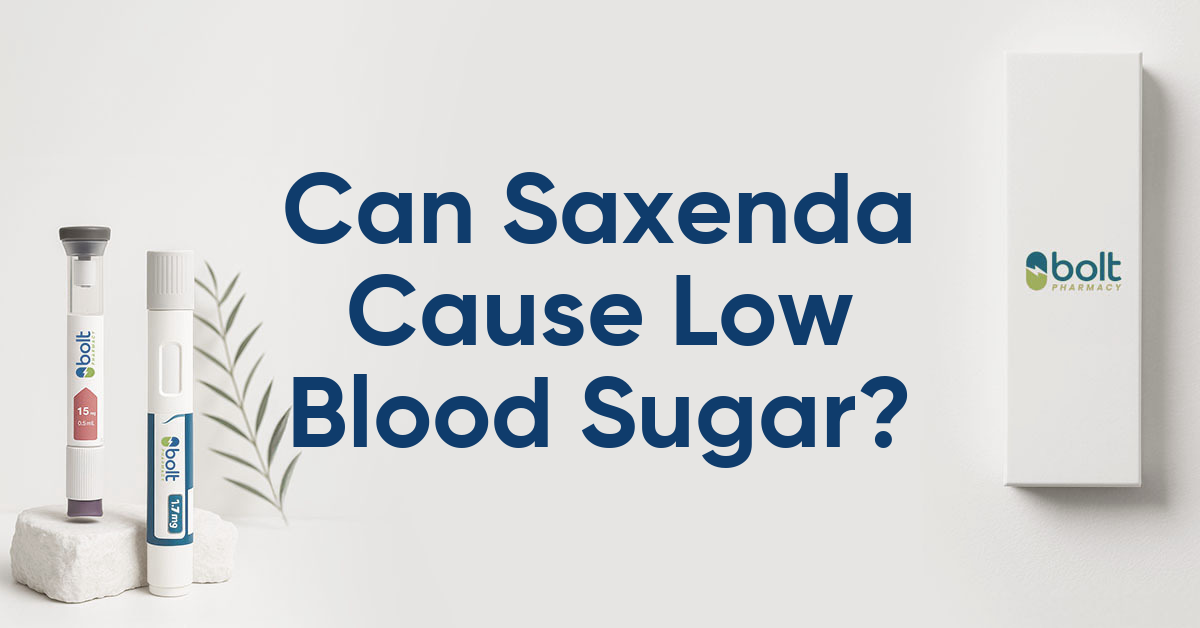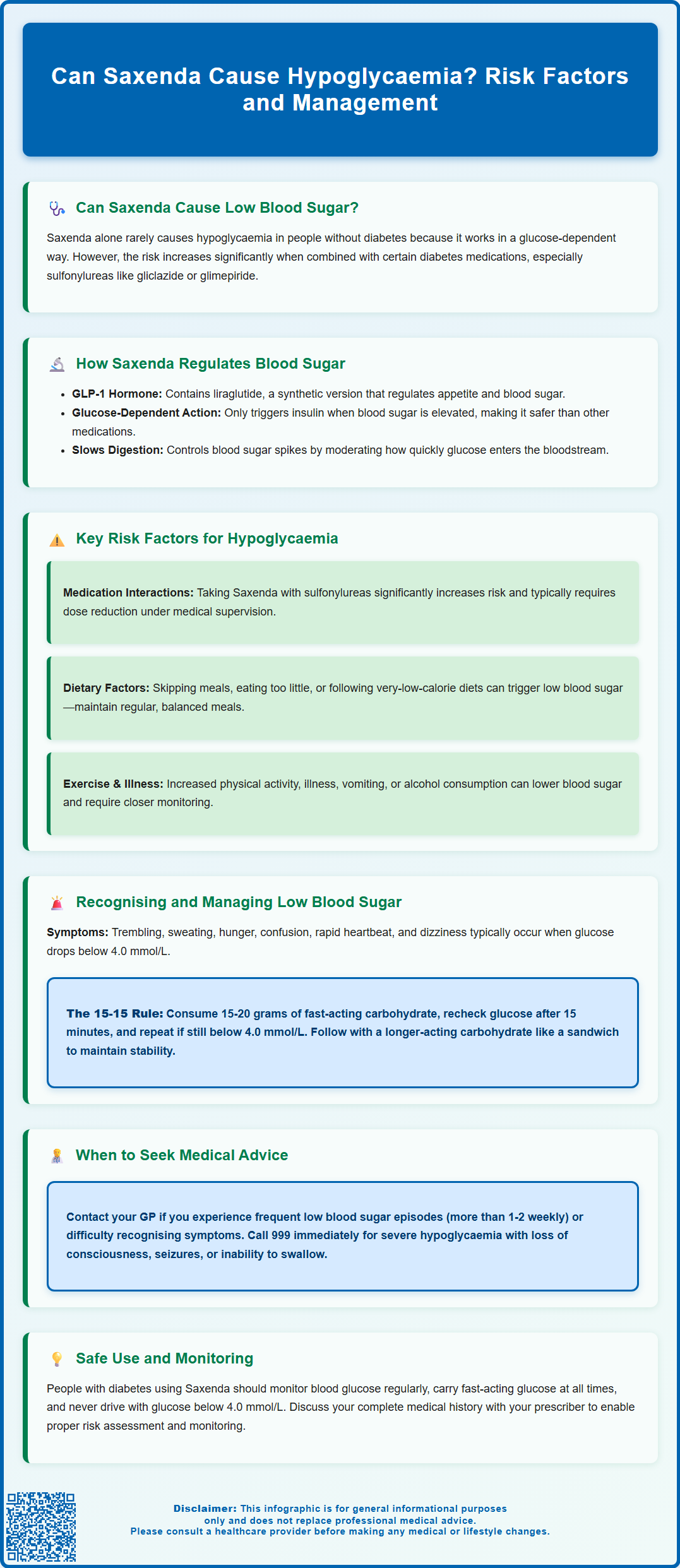Mounjaro®
Dual-agonist support that helps curb appetite, hunger, and cravings to drive substantial, sustained weight loss.
- ~22.5% average body weight loss
- Significant weight reduction
- Improves blood sugar levels
- Clinically proven weight loss

Can Saxenda cause hypoglycaemia? Hypoglycaemia is uncommon with Saxenda (liraglutide 3.0 mg) when used alone in people without diabetes, though minor symptomatic episodes have been reported. As a glucagon-like peptide-1 (GLP-1) receptor agonist, Saxenda works in a glucose-dependent manner, primarily stimulating insulin release only when blood glucose levels are elevated. However, the risk increases considerably when Saxenda is combined with certain diabetes medications, particularly sulfonylureas such as gliclazide or glimepiride. Understanding your personal risk factors and recognising early warning signs remains essential for safe medication use. This article examines the relationship between Saxenda and blood sugar regulation, identifies who may be at increased risk, and provides practical guidance on managing potential hypoglycaemic episodes.
Summary: Saxenda rarely causes hypoglycaemia when used alone, but risk increases significantly when combined with sulfonylureas or other diabetes medications.
Hypoglycaemia is uncommon with Saxenda (liraglutide 3.0 mg) monotherapy in people without diabetes, though minor symptomatic episodes have been reported. As a glucagon-like peptide-1 (GLP-1) receptor agonist, Saxenda works in a glucose-dependent manner, meaning it primarily stimulates insulin release when blood glucose levels are elevated. This mechanism significantly reduces the risk of low blood sugar compared to some other glucose-lowering medications.
However, the risk profile changes considerably when Saxenda is used alongside certain diabetes medications, particularly sulfonylureas (such as gliclazide or glimepiride). In these circumstances, there is an increased risk of hypoglycaemia, and dose adjustments of concomitant medications may be necessary. The Medicines and Healthcare products Regulatory Agency (MHRA) and Saxenda product literature clearly outline these interactions.
For individuals using Saxenda for weight management without diabetes, hypoglycaemia is uncommon and typically not a primary concern. Nevertheless, understanding your personal risk factors and recognising early warning signs remains important for safe medication use.
This article examines the relationship between Saxenda and blood sugar regulation, identifies who may be at increased risk, and provides practical guidance on recognising and managing potential hypoglycaemic episodes. If you have concerns about blood sugar levels whilst taking Saxenda, discussing these with your GP or prescribing clinician is essential for personalised advice.
Saxenda contains liraglutide, a synthetic version of the naturally occurring hormone GLP-1 (glucagon-like peptide-1). This hormone plays a crucial role in glucose homeostasis and appetite regulation. Understanding how Saxenda interacts with your body's blood sugar control mechanisms helps clarify why hypoglycaemia risk varies between individuals.
The glucose-dependent mechanism of action is key to Saxenda's safety profile. When blood glucose levels are normal or low, Saxenda does not significantly trigger insulin secretion from pancreatic beta cells. This differs fundamentally from medications like sulfonylureas, which stimulate insulin release regardless of glucose levels. Additionally, liraglutide suppresses glucagon secretion (a hormone that raises blood sugar) primarily during hyperglycaemia, providing a built-in safety mechanism against hypoglycaemia.
Saxenda also slows gastric emptying, which moderates the rate at which glucose enters the bloodstream after meals. This contributes to improved glycaemic control and reduced post-prandial glucose excursions. For people with type 2 diabetes prescribed liraglutide 3.0 mg for weight management, glycaemic parameters may improve, but it's important to note that Saxenda is not licensed for glycaemic control (Victoza is the diabetes indication).
In clinical trials for weight management in non-diabetic individuals, symptomatic hypoglycaemia was reported but confirmed low blood glucose events were rare. The European Medicines Agency (EMA) assessment of liraglutide confirms this generally favourable profile. However, individual responses can vary, and factors such as dietary intake, physical activity levels, and concurrent medications all influence blood glucose dynamics. Understanding these interactions enables safer, more effective use of Saxenda as part of a comprehensive weight management programme.

Whilst Saxenda monotherapy rarely causes hypoglycaemia, several risk factors can increase susceptibility to low blood sugar episodes. Identifying these factors allows for appropriate precautions and monitoring strategies.
Concomitant use of diabetes medications represents the most significant risk factor. Individuals taking sulfonylureas alongside Saxenda face substantially elevated hypoglycaemia risk, as established in clinical trials. When initiating Saxenda in these circumstances, prescribers typically reduce doses of sulfonylureas to mitigate this risk. NICE guidance on type 2 diabetes management (NG28) emphasises the importance of medication review when adding GLP-1 receptor agonists to existing treatment regimens. Patients should never adjust diabetes medication doses independently without medical supervision.
Inadequate caloric intake or irregular eating patterns can precipitate hypoglycaemia, particularly in individuals with diabetes. Saxenda's appetite-suppressant effects may lead some people to skip meals or consume insufficient carbohydrates. Very-low-calorie diets or fasting can further increase risk. Whilst caloric restriction supports weight loss objectives, excessively low intake combined with glucose-lowering medications creates conditions conducive to hypoglycaemia. Maintaining regular, balanced meals helps stabilise blood glucose levels.
Increased physical activity enhances insulin sensitivity and glucose utilisation by muscles, potentially lowering blood sugar levels. Individuals significantly increasing exercise intensity or duration whilst taking Saxenda—especially those with diabetes—should monitor blood glucose more frequently and may require medication adjustments.
Other important risk factors include: intercurrent illness, vomiting or diarrhoea (causing reduced intake or dehydration), alcohol consumption (which can impair glucose regulation), and beta-blockers (which may mask some warning symptoms of hypoglycaemia). Renal impairment can affect medication clearance and glucose metabolism; the Saxenda SmPC advises caution in severe renal impairment and does not recommend use in end-stage renal disease.
Early recognition of hypoglycaemia is crucial for prompt management and prevention of more severe episodes. Whilst uncommon with Saxenda alone, individuals at risk should understand warning signs and appropriate responses.
Common symptoms of hypoglycaemia include:
Trembling or shakiness
Sweating and clamminess
Hunger sensations
Irritability or mood changes
Difficulty concentrating or confusion
Palpitations or rapid heartbeat
Pallor (pale appearance)
Headache and dizziness
Symptoms typically occur when blood glucose falls below 4.0 mmol/L, though individual thresholds vary. Some people experience hypoglycaemia unawareness, where warning symptoms are diminished or absent, making regular blood glucose monitoring particularly important for at-risk individuals.
Immediate management of mild to moderate hypoglycaemia follows established protocols. The '15-15 rule' is widely recommended: consume 15–20 grams of fast-acting carbohydrate (such as glucose tablets, 150–200ml of fruit juice, or 4–5 jelly babies), then recheck blood glucose after 15 minutes. If levels remain below 4.0 mmol/L, repeat the treatment. Once blood sugar normalises, consume a longer-acting carbohydrate (such as a sandwich or biscuits) to maintain stability. Avoid chocolate or fatty foods for initial treatment as they slow glucose absorption.
For individuals with diabetes using Saxenda, maintaining a blood glucose meter and testing supplies is essential. Regular monitoring—particularly before meals, before driving, and when experiencing symptoms—enables early detection and intervention. Do not drive if you feel hypoglycaemic or have glucose <4.0 mmol/L, and follow DVLA guidance if you have diabetes. Carrying fast-acting glucose sources at all times provides security and enables immediate treatment if needed.
Severe hypoglycaemia, characterised by confusion, loss of consciousness, or seizures, requires emergency treatment with glucagon (intramuscular/subcutaneous or nasal formulations are available) and immediate medical attention by calling 999. Family members and close contacts should be informed about hypoglycaemia recognition and emergency procedures for individuals at higher risk.
Knowing when to contact healthcare professionals about blood sugar issues ensures safe Saxenda use and prevents complications. Several situations warrant medical review or urgent attention.
Contact your GP or prescribing clinician if you experience:
Recurrent hypoglycaemic episodes (more than one or two per week)
Hypoglycaemia occurring at unusual times, particularly overnight
Difficulty recognising hypoglycaemia symptoms (hypoglycaemia unawareness)
Blood glucose readings consistently below 4.0 mmol/L
Uncertainty about managing blood sugar whilst taking Saxenda
Significant changes in eating patterns or physical activity levels
New medications that might interact with Saxenda or affect glucose control
Medication review may be necessary if hypoglycaemia becomes problematic. For individuals with diabetes, adjustments to sulfonylurea doses often resolve recurrent low blood sugar episodes. Your healthcare provider can assess your overall treatment regimen and make appropriate modifications whilst maintaining effective glucose and weight management.
Seek immediate medical attention (call 999 or attend A&E) if:
Severe hypoglycaemia occurs with loss of consciousness or seizures
You are unable to swallow or safely consume carbohydrates
Blood glucose remains dangerously low despite treatment
You experience chest pain, severe confusion, or other concerning symptoms alongside low blood sugar
For urgent but non-emergency advice when you cannot reach your care team, contact NHS 111.
Before starting Saxenda, discuss your complete medical history with your prescriber, including all current medications, diabetes status, and any previous hypoglycaemic episodes. This enables appropriate risk assessment and monitoring plans.
Follow-up appointments are essential for treatment assessment. According to the Saxenda SmPC, you should be reviewed after 12 weeks on the full 3.0 mg dose, and treatment should be discontinued if at least 5% weight loss has not been achieved. Subsequent reviews will be arranged as clinically appropriate. These consultations provide opportunities to discuss any blood sugar concerns and optimise your treatment plan.
If you experience any suspected side effects with Saxenda, report them via the MHRA Yellow Card scheme (yellowcard.mhra.gov.uk or via the Yellow Card app).
Saxenda works in a glucose-dependent manner, meaning it primarily stimulates insulin release only when blood glucose is elevated. In people without diabetes using Saxenda for weight management, hypoglycaemia is uncommon and typically not a primary concern.
Sulfonylureas such as gliclazide and glimepiride significantly increase hypoglycaemia risk when used alongside Saxenda. Dose adjustments of these diabetes medications are typically necessary when initiating Saxenda, and should only be made under medical supervision.
Follow the '15-15 rule': consume 15–20 grams of fast-acting carbohydrate (glucose tablets, fruit juice, or jelly babies), then recheck blood glucose after 15 minutes. If levels remain below 4.0 mmol/L, repeat the treatment. Contact your GP if hypoglycaemic episodes become recurrent.
The health-related content published on this site is based on credible scientific sources and is periodically reviewed to ensure accuracy and relevance. Although we aim to reflect the most current medical knowledge, the material is meant for general education and awareness only.
The information on this site is not a substitute for professional medical advice. For any health concerns, please speak with a qualified medical professional. By using this information, you acknowledge responsibility for any decisions made and understand we are not liable for any consequences that may result.
Lorem ipsum dolor sit amet, consectetur adipiscing elit, sed do eiusmod tempor incididunt ut labore et dolore magna aliqua. Ut enim ad minim veniam, quis nostrud exercitation ullamco laboris nisi ut aliquip ex ea commodo consequat. Duis aute irure dolor in reprehenderit in voluptate velit esse cillum dolore eu fugiat nulla pariatur.
Block quote
Ordered list
Unordered list
Bold text
Emphasis
Superscript
Subscript